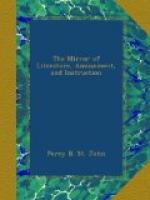31 and 33. Landscape and Figures. Morland.
34. Diana and Calista. Wilson. A beautifully poetic composition: yet the painter lived and died nearer to indigence than ease.
35. Alexander Pope and Martha Blount. Jervas. Of comparatively little interest for its pictorial merit; though Pope has enshrined the painter in elegant couplet. If poetry and painting be sister arts, they are rarely twin.
41 and 227. Dead Game, &c. Blake. Among the finest compositions of their class. It is worth while to compare these pictures, with what Smith, in his Life of Nollekens, tells us of Blake’s colouring: “his modes of preparing his grounds, and laying them over his panels for painting, mixing his colours, and manner of working, were those which he considered to have been practised by the early fresco painters, whose productions still remain in many instances vividly and permanently fresh. His ground was a mixture of whiting and carpenters’ glue, which he passed over several times in the coatings; his colours he ground himself and also united with them the same sort of glue, but in a much weaker state; he would in the course of painting, pass a very thin transparent wash of glue-water over the whole of the parts he had worked upon and then proceed with his finishing.”
43. The Captive, Jackson. One of the finest pictures in the room. In colouring it approaches the olden school nearer than any recent specimen.
44. Carnarvon Castle, Moon-rising. E. Childe. A clever picture, and altogether an interesting scene.
53. Portrait of the late Queen Caroline, and the Princess Charlotte. Lawrence. One of the painter’s early productions. The attitude of the Queen beside a harp is majestic, and her figure is not of such bulky proportion as she attained in after-life; the features are, too, more intelligent than many beneath a crown: the figure of the darling Princess in sportive mood, half clambering and reclining upon a chair, is pretty. Indeed, the picture, as well from its characters as from its merit and size, must command considerable interest in the collection. It may have associations of melancholy tendency; for the princesses and the painter have been numbered with the dead within a score of years.
55. The Benevolent Squire. Morland. A small oval picture of touching truth and nature. In the foreground is a widow, with two children, seated beside a cottage door. They have just divided a small loaf with hungry zest: in the distance is an old English ’squire on horseback, who is instructing his groom with undrawn purse to relieve the wants of the widow, while the good Samaritan casts an eye of true compassion at the almost starving group.
58. Portrait of Opie. Opie: showing, as Mr. Cunningham observes, “a noble forehead and an intellectual eye,” with much of his country, Cornish air. The picture is but of few inches dimension, in a homely, broad, flat, oaken frame, somewhat resembling that of a miniature, with the name “Opie,” plainly cut in capitals. It is noticeable for its unadornment.




